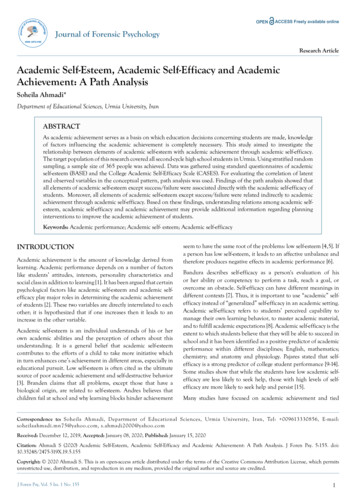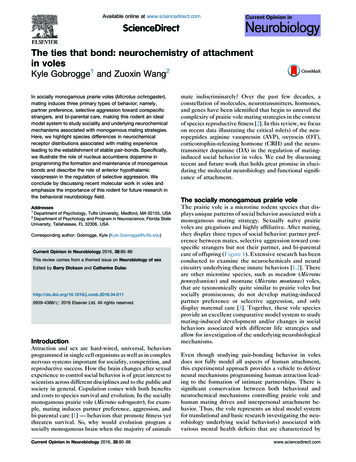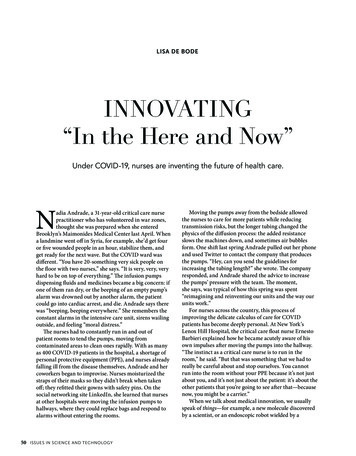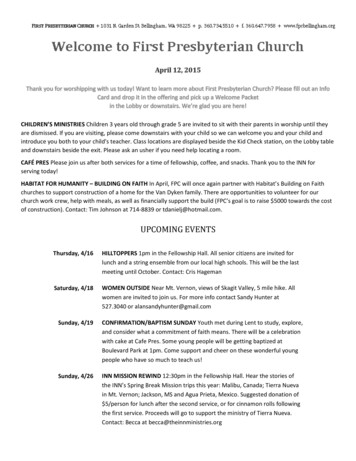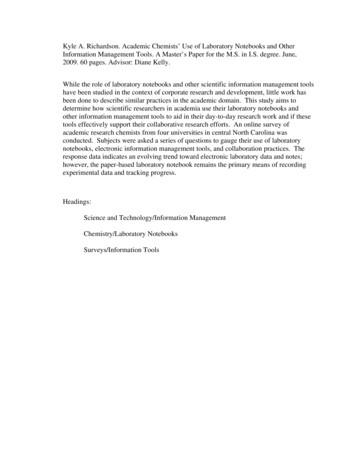
Transcription
Kyle A. Richardson. Academic Chemists’ Use of Laboratory Notebooks and OtherInformation Management Tools. A Master’s Paper for the M.S. in I.S. degree. June,2009. 60 pages. Advisor: Diane Kelly.While the role of laboratory notebooks and other scientific information management toolshave been studied in the context of corporate research and development, little work hasbeen done to describe similar practices in the academic domain. This study aims todetermine how scientific researchers in academia use their laboratory notebooks andother information management tools to aid in their day-to-day research work and if thesetools effectively support their collaborative research efforts. An online survey ofacademic research chemists from four universities in central North Carolina wasconducted. Subjects were asked a series of questions to gauge their use of laboratorynotebooks, electronic information management tools, and collaboration practices. Theresponse data indicates an evolving trend toward electronic laboratory data and notes;however, the paper-based laboratory notebook remains the primary means of recordingexperimental data and tracking progress.Headings:Science and Technology/Information ManagementChemistry/Laboratory NotebooksSurveys/Information Tools
ACADEMIC CHEMISTS’ USE OF LABORATORY NOTEBOOKS AND OTHERINFORMATION MANAGEMENT TOOLSbyKyle A. RichardsonA Master’s paper submitted to the facultyof the School of Information and Library Scienceof the University of North Carolina at Chapel Hillin partial fulfillment of the requirementsfor the degree of Master of Science inInformation Science.Chapel Hill, North CarolinaJune 2009Approved byDiane Kelly
1Table of ContentsIntroduction . 2Literature Review. 6Meeting Information Needs Electronically. 6Importance of the Laboratory Notebook. 7Information Management Practices . 8Electronic Laboratory Notebooks . 11Summary . 13Methods. 15Subjects . 15The Survey Instrument. 17Procedures . 18Advantages and Disadvantages. 19Results . 21Demographics . 21The Lab Notebook . 23Electronic Information . 28Collaboration. 32Analysis. 36Discussion . 39Role of the Laboratory Notebook . 39Current Information Management Tools . 41Effectiveness of Current Practices . 42Implications. 43Future Work . 44Conclusion . 46References . 48Appendix A: Survey Invitation . 50Appendix B: Online Consent Form . 51Appendix C: Survey Instrument . 53
2IntroductionScientists rely heavily on their laboratory notebooks as the definitive record of theirresearch work. Scientific research is built upon the principle that all results can bereplicated given an appropriate description of the experiment, and the laboratorynotebook is a vital piece of that documentation. Traditionally, laboratory notebooks havebeen bound, paper-based artifacts that not only serve as the record of a researcher’s workbut also as his/her personal research journal (schraefel et al., 2004). In addition to thebasic experimental description and results, researchers record insight into their thoughts,ideas, and experiences. These can be extremely important to the overall research processbut may or may not have any bearing on the reproducibility of a specific experiment.With the advancements in technology and scientific instrumentation, scientists arenow able to collect huge amounts of data for each experiment they perform. Advancedcomputing algorithms have aided analysis of these massive data sets, but researchers stillsuffer from information overload with each new experiment they perform. In addition tothe shear amount of data generated, modern scientists have benefited from advancementsin technology, specifically personal computers and the Internet, to write and store theirpublished work, communicate and collaborate with fellow researchers, and cross thetraditional boundaries of their disciplines. While all of these advances have greatlyincreased the productivity of scientific research, they have left in their wake a new set ofproblems.
3Scientists now have many disconnected forms and locations where their data,observations, thoughts, and finalized work are maintained and stored. Many have textand document files on their personal computer, raw and analyzed data sets on laboratorycomputer systems, and a handwritten record that binds it all together in the form of apaper-based laboratory notebook. In recent years, private sector research anddevelopment (R&D) has begun to realize the vast amount of knowledge stored inlaboratory notebooks that is lost or overlooked due to the inability to effectively searchthose records (Taylor, 2006). Corporate R&D environments have thus been searching foran electronic laboratory notebook (ELN) solution that would allow their researchers tocombine all aspects of their work into a single system that could then be searched byother researchers within the company. They believe this will cut down on redundancyand provide a more accessible record of the company’s overall R&D performance. Inaddition, an ELN system would be designed to integrate into a company’s existing R&Dworkflow, which is nearly entirely computer-based already (Taylor, 2006).Scientific researchers in academia, however, have remained skeptical of ELN systemsand very few have implemented a broad-spectrum electronic information managementsolution (Butler, 2005). This is most notably due to a fully integrated system’s rigidity.Researchers in academia have a lot more freedom than those involved in private sectorR&D and do not want to be bound to a one-size-fits-all solution. Most are free to studywhatever topics they wish and often workflows vary widely from one research lab toanother. While these aspects often support a greater quest for knowledge in areas that thecorporate world are uninterested in, it creates a major problem with respect to integratingan entire university community into any standardized electronic information management
4system. University culture is based on freedom and openness, and this model simplydoes not support those ideals. Because of the very open nature of the academicenvironment, there are a number of possibilities for how each laboratory and potentiallyeach researcher have chosen to manage and store all of their information.Collaborative research is growing in importance in both the academic and privatesector arenas as the demand for scientific advancements and breakthroughs skyrockets.With the advancements in data collection and overall explosion of scientific data,researchers are beginning to develop closer ties with one another. Once scattered andconcerned only with their current work, researchers are now actively seeking outcolleagues with similar interests to tackle problems too large for a single researcher orlaboratory. Collaborative research is becoming more and more commonplace with theadvances in communication technologies and the ability to readily access and share datasets over the Internet. Researchers are still concerned with maintaining control over theirwork but are realizing the importance of multiple thoughts and opinions to continuallydevelop innovative ideas and solutions to today’s problems.The purpose of this study is to determine the various forms the scientific laboratorynotebook takes in an academic research environment and whether, in its current form, itis meeting the information management needs of research scientists. This study will alsodetermine if current information management practices are effective in providing supportfor collaborative research. The specific research questions this study will address are:1. What role does the laboratory notebook serve in scientific informationmanagement practices and what forms does it take?
52. What electronic information management tools, other than the laboratorynotebook, are currently being used to support research and collaboration efforts?3. How effective are researchers' current information management practices and howwilling are they to explore alternatives?
6Literature ReviewIn order to develop an understanding of the information management needs ofacademic researchers in the natural sciences, it is first necessary to gain some insight intothe types of research information they currently manage and how they meet theirparticular information needs. Additionally, since current information managementpractices revolve around the laboratory notebook, it is important to develop a workingknowledge of the various affordances it provides as well as the functions it supports inresearch work. Beyond the laboratory notebook, scientists use a variety of other,supplemental, information management tools to organize and access their researchmaterials. An overview of the various tools being used will also be presented. Finally,the current state of ELN systems along with the features they provide and needs theymeet will be discussed. The importance and challenges of effectively supporting researchcollaboration will be stressed.Meeting Information Needs ElectronicallyIn order to understand how scientists choose to manage research information, it isfirst necessary to understand how they retrieve and store the information required tosupport their work. Research has shown that the vast majority of scientific informationneeds are now being met electronically. Over 70% of respondents to a survey onscientific information seeking behavior indicated that they used either citation databasesearching, such as SciFinder Scholar, or online web searching, such as Google, as their
7primary means of gathering research information (Hemminger, Lu, Vaughan, & Adams,2007). Additionally, researchers in the natural sciences, chemists in particular, tend torely almost solely on peer-reviewed journal articles to support their research and often areinterested only in recently published material, generally within the last 5 years (Brown,Blake, Brown, & Tenopir, 2006). Because of this, scientists are able to retrieve nearly allof the research articles of interest to them electronically from either the publisher’swebsite or a digital library and store them electronically on their personal computers.Interestingly enough, although researchers prefer to gather their informationelectronically, the majority of them still prefer to read materials in printed form(Hemminger et al., 2007). While this behavior is undoubtedly common, it may shedsome additional light on the resistance to move to an entirely digital informationmanagement system.Importance of the Laboratory NotebookAs far back as the mid-1990s, private-sector scientists were beginning to understandthe need to access and share the information contained in laboratory notebooks.Laboratory notebooks contain a log of all experiments performed by a particularresearcher as well as an initial interpretation of their findings (Dessy, 1995). Publishedjournal articles and reports that derive from those findings never include all of theinformation originally found in the laboratory notebook, and this information can be veryimportant if the work is to be repeated or enhanced by someone else. Additionally,researchers now gather more and more data in digital formats making it harder tointegrate with the traditional laboratory notebook. Images and data tables are oftenprinted out and glued into the notebook to maintain records; however, the file names and
8locations are often not included causing potential retrieval problems when the data isneeded for additional analysis or review (Butler, 2005).Companies and organizations in the private sector have realized that a great deal ofthe valuable information in laboratory notebooks is being lost (Taylor, 2006). Paperbased notebooks cannot be easily searched and are often difficult to interpret andunderstand by anyone besides the original author. Additionally, scientists are oftenperforming several experiments in parallel making the chronological progression of thelaboratory notebook less useful since a single experiment may skip from page to page asthe researcher works on other projects (Dessy, 1995). Laboratory notebooks are also thelegal records required as evidence for patent and intellectual property disputes and cancause the organization embarrassment if the writing is eligible or pages are lost ordestroyed over the years (Kihlen, 2005). Although these issues may be morecommonplace in private sector industry, academic research laboratories and institutessuffer from the same general problems only on a slightly smaller scale.Information Management PracticesUnderstanding how researchers currently utilize the laboratory notebook and othersupplemental information management tools is extremely important if new tools andsolutions are to be developed to support their efforts.According to a study of industry chemists in the UK, paper-based laboratorynotebooks are primarily used to record the measurements taken in the laboratory andobservations as the experiment progresses but very little about the actual procedure usedto perform the experiment (schraefel et al., 2004). This information is instead recorded ina separate document since the experiment will likely be repeated several times.
9Researchers within a discipline or even a particular lab tend to rely on a commonknowledge of certain procedures and terms. This results in documentation that is difficultto understand without the community specific knowledge (schraefel et al., 2004). What aresearcher records in the laboratory notebook also depends on the researcher’s own style.For example, one researcher might record the batch number of a substance used whileanother may not find that information important (schraefel et al., 2004). Additionally,these notebooks are subjected to highly volatile conditions throughout the course of anormal day as researchers place them wherever they can find room around theirworkbench and instruments. The potential for damage and destruction of notebook isquite high in this environment, which can cause entire pages of a laboratory notebook oreven entire experiments to be lost.In addition to the laboratory notebook most researchers have at least one, and usuallyseveral, other notebooks in which they track different kinds of research relatedinformation (Reimer & Douglas, 2004). These can include publication notebooks, groupmeeting notebooks, travel notebooks, and many others. Additionally, these are generallyfound in a variety of media formats. For example, a publication notebook could be aWord document that includes notes and an outline for an upcoming publication, while atravel or group meeting notebook could be a simple spiral notebook or notepad that iseasily taken to meetings and conferences and contains notes on others work and ideas forfuture research.Researchers in the natural sciences seem to generally struggle with how to organizeand find their data (Tabard, Mackay, & Eastmond, 2008). In recent years, this problemhas escalated due to the huge amounts of data capable of being generated by each
10experiment. Researchers will generally collect as much data as possible even if theyknow they will not be analyzing all of it (Birnholtz & Bietz, 2003). The thought is thatthey can share these raw data sets with other researchers who may be interested inanalyzing some portion of it.The actual organization of a scientist’s information is often scattered. They are usingso many different tools that portions of their research information could be stored inWord documents, e-mail messages, paper-based laboratory notebooks, meetingnotebooks, and at times even blogs, wikis, or web pages (Tabard et al., 2008). All ofthese different sources cannot be easily organized into a single structure and thus retrievalof information is extremely difficult and becomes worse the further back the informationwas recorded. Often researchers can easily remember what they have been working onover the past week or even month, but beyond that a person’s memory is not adependable retrieval mechanism (Tabard et al., 2008).While computer use is pervasive in nearly all aspects of scientific research work,nearly 75% of the industry biologists interviewed in a French study continue to usepaper-based laboratory notebooks (Tabard et al., 2008). This is due in part to therigorous scientific training they have undergone. Scientific researchers are taught earlyon to write clearly and concisely the important aspects of the experiment they areperforming and to never delete or edit the information once it has been recorded. Editinginformation in the laboratory notebook is highly discouraged due to the legal nature ofthe notebook should patents or intellectual property claims wish to be filed in the future.
11Electronic Laboratory NotebooksDue to the high demand for an integrated digital solution in private sector industry,there has been quite a bit of work done to understand the needs of scientific researchersand to develop novel and even some commercial ELN systems to support those needs. Itis important to note that the vast majority of this work concentrates on the corporateenvironment and provides little insight into the needs specific to academic researchers.The fundamental role that any successful ELN system should fulfill for private-sectorR&D is the ability to maintain accurate, legal records of research in accordance with USpatent laws (Myers, 2003). There are a number of challenges that must be addressed herein order to map the paper-based laboratory notebook requirements to an electronicequivalent. Signed notebook pages are necessary to comply with these laws and must beaddressed. One solution is to maintain all records on a central server where the data issaved once entered and is unchangeable (schraefel et al., 2004). Another is to implementa public key digital signature, which can only be applied by the author (Myers, 2003).Additionally, the ability to print out physical copies of these documents in the form ofstandardized reports, which include all the necessary information and look professional isessential (Kihlen, 2005). These documents can then be sent to government agencies ifneeded as well as be stored on-site as a physical backup of the research work beingperformed.ELN systems have been shown to produce higher quality information than traditional,paper-based laboratory notebooks in an industry setting. Researchers recognize that theywill not be the only ones using and relying on the information and make a consciouseffort to provide lengthier descriptions and more detailed notes regarding their activities
12(Kihlen, 2005). They find it beneficial to be able to see what others are working on andhow it relates to their own current projects.A variety of systems, both fully digital as well as digital-paper hybrids, have beendeveloped over the last several years and have identified some of the main featuresneeded by the scientific community. The ability of the system to integrate personalproductivity features such as access to e-mail, calendaring, file system documents, andweb browser is essential (Myers, 2003; Tabard et al., 2008). Most researchers depend one-mail as a vital source of scholarly communications from colleagues and collaborators,and the ability to tag messages for a particular project or experiment would avoid theneed to re-write information and reduce the transposition errors that might occur. Theability to support advanced search and retrieval of information is also critical. One of themain downsides of the paper-based laboratory notebook is the inability to effectivelysearch those records. Researchers would save time and frustration by being able tosearch their laboratory notebooks for a specific experiment or concept. Additionally, theability to provide long-term preservation and archival of research information would bean important feature of any ELN system (Myers, 2003). Researchers need an organizedway to provide for long-term storage. Currently this consists mostly of boxes filled withpublications, laboratory notebooks, and DVDs of archived raw data files that are noteasily retrieved. While these features are all important in order to provide for thescientists needs in an information management system, the most pressing need andsought after feature is the ability to collaborate and share research information.Scientific research has become an increasingly more collaborative arena. In the past,researchers were hesitant to share data and procedures for fear that another investigator
13would beat them to a discovery. Today, scientists are generating so much data that theyneed the help of collaborators to analyze and understand it all. Not only do researchersneed an electronic information management system, they need a way to share some or allof the information in that system with others (Birnholtz & Bietz, 2003). They may needto share it with others members of their laboratory or organization or they may want toshare it with external collaborators that span across industry and academia as well asaround the globe.SummaryScientific researchers, specifically those in the natural sciences such as chemistry andbiology, rely on their laboratory notebooks to provide the glue that holds all of theirresearch data and materials together. As the Internet and personal computers havebecome commonplace in society, they have also become a mainstay in researchlaboratories and an essential part of the research workflow. Scientists are now able tosearch and retrieve research materials using databases and search engines from thecomfort of their offices and laboratories. They are also able to utilize complexinstruments and computational algorithms to gather huge amounts of raw data. Oncescientists have gathered all of this information, they need to be able to organize it foreasier use. This is where many researchers struggle. Their laboratory notes are notadequate to describe all of the different sources of research information they are utilizing.Additionally, multiple experiments and lines of research running in parallel make it moredifficult to manage the information using a traditional laboratory notebook.Electronic laboratory notebooks have become a buzzword in the private sectorbecause of the potential productively increase and streamlining of data and resource
14management. ELN systems can provide the legal documentation necessary to file patentsand often result in higher quality information than that provided in a personal, paperbased laboratory notebook. They can also allow for the integration of all of anorganization’s information into a central repository of knowledge. This institutionalknowledge can then be preserved even as researchers come and go over the years.Additionally, ELN systems can better support the collaborative efforts of scientificresearchers today. Many scientists have begun to work in teams on research projects toincrease productivity and bring a greater range of knowledge and experience to theproblem. The ability to effectively share research information and materials over theInternet to collaborators around the world provides great potential for the advancement ofscience.
15MethodsAcademic research chemists’ current use of laboratory notebooks and other scientificinformation management tools were investigated using a survey method. Specifically, anonline questionnaire was used to provide an easy interface for subjects to respond withoutrequiring a large time commitment. Surveys are an excellent way to describe thebehavior of a large population without direct observation (Babbie, 2007). This allows theinvestigation of a broad range of subjects from a population that has not been previouslydescribed in the literature.SubjectsWhile this research could be broadly applied to academic research scientists, thisstudy focuses on researchers in the field of chemistry. Specifically, the target subjectpopulation included researchers in the Departments of Chemistry from four majorresearch universities in North Carolina. These included the University of North Carolinaat Chapel Hill, North Carolina State University, Duke University, and Wake ForestUniversity. All subjects were over 18 years of age and of varying gender, ethnicity, andrace. Additionally, all subjects had completed a bachelor’s degree program and wereactively conducting chemical research at one of the above mentioned institutions at thetime of the study. Completion of a bachelor’s degree indicates some level of researchexperience and a desire to continue conducting research in the field.
16Sampling was done by convenience (those who chose to complete the online survey).Subjects were recruited through an e-mail invitation sent to various electronic mailinglists of the departments being studied (Appendix A). The business manager of eachdepartment was contacted and asked to forward the survey invitation to all graduatestudents, postdoctoral researchers, staff scientists, and professors in their department.The e-mail text contained a brief description of the study and an invitation to participatein the study. Halfway through the study, a second reminder e-mail was sent to thedepartment business mangers to be forwarded on to the same mailing lists as the originalinvitation. Because of the use of various departmental mailing lists, there was no way todetermine the exact size of the population and thus it was impossible to accuratelycompute a response rate.Care was taken to ensure that all subjects were comfortable participating in the studyand that they understood their rights as subjects. Before beginning any data collection,the Institutional Review Board (IRB) was consulted for their approval of this study andall of its proposed procedures. Approval was secured under IRB Study # 09-0721.Subjects were asked to read and acknowledge their understanding of a standard onlineconsent form prior to participating in the study (Appendix B). No identifiable data wascollected and all subjects’ responses were completely anonymous. The Qualtrics system,which was used to provide the online survey to subjects, does collect the IP address of thecomputer used to complete and survey, but these were destroyed prior to data analysis toensure subject anonymity. The researcher was the only one with access to the surveydata and it was stored on a secure server throughout the analysis period. The data will bekept as a record of this study after its completion, but, as it is completely anonymous,
17there is no risk of subjects ever being identified from it and it is highly unlikely thatsubjects’ identities can be deduced from their survey responses.Subjects will not directly benefit from this study in any way; however, this study doeshope to benefit the overall scientific community by providing a descriptive analysis of thecurrent usage of laboratory notebooks and other tools to manage scientific information inan academic environment. This information could then potentially be used to suggestadditional tools and strategies to scientific researchers as well as to devel
conducted. Subjects were asked a series of questions to gauge their use of laboratory notebooks, electronic information management tools, and collaboration practices. The response data indicates an evolving trend toward electronic laboratory data and notes; however, the paper-based laboratory notebook remains the primary means of recording




